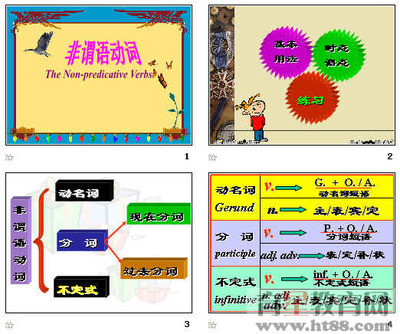——非谓语动词
非谓语动词指的是在句中起名词,形容词或副词作用的动词形式,而不是作谓语的动词形式。动词的非谓语形式分为动名词,分词,动词不定式。
Climbing mountain is a good exercise. (Climbing...,动名词起名词作用)
Do you know the man wearing a white shirt.(wearing ..分词起形容词作用)
He gets up early to catch the first bus. (to catch ...不定式起副词作用)
谓语动词和非谓语动词的区别:
1)谓语动词在句中可单独作谓语,而非谓语动词不能单独作谓语。
Miss Mary teaches us English.玛丽教我们英语。(teaches动词作谓语)
Mr. Li came to our classroom to have a talk with us last week.
(to have a talk....不定式作状语)
2)谓语动词受主语的人称和数的限制,而非谓语动词形式没有这种限制。
Mike likes the pop music.(动词用单数第三人称形式)
Lucy has nothing to do today。(do用原形)
非谓语动词的特征:
1如果非谓语动词是及物动词,后面须跟宾语。
Studying English is my favorite.(studying后跟宾语)
To help him is my duty.帮助他是我的责任。(help后跟宾语)
2非谓语动词可以带有自己的状语或逻辑主语。
Working under such a condition is terrible.(under such a condition是working的状语)
It's too difficult for him to master English in such a short time.(for him作不定式的逻辑主语)
3非谓语动词仍有语态和时态的变化。
I am sorry to have kept you waiting long.(to have kept...是不定式的完成形式)
Seen from the mountain, the city looks much more beautiful.(Seen from...是分词的被动形式)
4非谓语动词在句中可以当成名词或者形容词来使用。
Our coming made him happy.(coming起名词作用)
There are two big swimming pools here.(swimming起形容词作用)
非谓语动词的形式变化:
不定式主动被动
一般 to write to be written
进行 to be writing
完成 to have written to have been written
完成进行 to have been writing
现在分词 主动 被动
一般 writing being written
完成 having written having been written
过去分词 主动被动
一般 written
动名词 主动被动
一般 writing being written
完成 having written having been written
●动词不定式:
动词不定式是由to +动词原形构成,在句中起名词,形容词和副词的作用,可以担任除谓语以外的其它任何成分。
1.动词不定式作主语:
To mast a language is not an easy thing.
To teach English is my favorite.
It's my pleasure to help you.
动词不定式作主语时可以放在后面,而用it作形式主语放在原主语的位置上。
It's very kind of you to have given us much help.
你给了我们那么多的帮助真是太好了。
It's necessary to find the witness.有必要找到目击者。
2.动词不定式作宾语:
某些及物动词可以用动词不定式作宾语,这些动词有decide, begin, help, begin, want, wish, like, forget, learn, ask.
What I wish is to learn English well.
I like to help others if I can.
3.动词不定式作宾语补语。
We expect you to be with us.我们希望你和我们在一起。
Please ask him to come here quickly.请叫他快过来。
4.动词不定式作表语:
What I should do is to finish the task soon.我应该做的是赶快完成任务。
The most urgent thing is to find the boy immediately.当务之急是马上去找孩子。
5.动词不定式作定语:
There are many ways to solve the problem.有许多方法能解决这个问题。
I have something important to tell you.我有重要的事情要告诉你。
6.不定式作状语:
We went to the hospital to see our teacher.我们去医院看了我们的老师。
She is making a test to get a kind of useful medicine from a Tibet flower.
她在做试验,从一种西藏花中提取某种有用的药物。
动词不定式的否定形式:
not + to +动词原形
The teacher told us not to swim in that river.
老师告诉我们不要在那条河里游泳。
It's unfair not to tell us.没告诉我们真是不公平。
带疑问词的不定式:
疑问词who, what,which,when, where, how, why可以加在不定式的前面,构成不定式短语,使含义更加具体。
Where to go is not known yet.去什么地方还不知道。
I don't know when to begin.我不知道什么时间开始。
Can you tell me where to get the battery.
你能告诉我哪儿能买到电池吗?
Do you know how to get to the station.你知道怎样去车站吗?
带逻辑主语的不定式:
动词不定式可以带有自己的逻辑主语,构成方法是:for +逻辑主语+不定式。
注意:逻辑主语用宾格形式,for本身无实际意义,它只表明后面的主语从逻辑上分析是不定式的主语。
It's necessary for us to help each other.我们互相帮忙是必要的。
There are much work for me to finish,有许多工作要我去完成。
动词不定式的被动形式:表示不定式动词同所修饰的名词是被动关系。
He is the man to be examined.他是受检查的人。
There are much work to be done.有好多工作要做。
●动名词
动名词是由动词原形+ ing构成,同现在分词形式一样,在句中可作主语,宾语,表语和定语。
1)动名词作主语:
Talking like that is not polite.
Learning from others is important .
Putting on more clothes is not so good .
(注:动名词可以象动词不定式一样,用it先行祠代替,而把动名词写在后面。
It's no use waiting here, let's go home.
It's very difficult climbing this mountain.
2)动名词作表语
The nurse's job is looking after the patients.
Seeing is believing.
3)动名词作宾语
有些动词须用动名词来作宾语,它们是begin, mind, suggest, finish, stop, need, enjoy, miss, keep.
Please stop smoking in the house.
I like reading in the forest.
Do you mind my opening the windows?
4)动名词作定语
She is studying in the reading room.
He slept in the sleeping bag.
(动名词的否定形式:not +动名词
He pretend not knowing it at all.他假装全然不知。
We considered not doing it now.我们考虑现在不做这件事。
动名词的被动形式:
(当动名词和它的逻辑主语是被动关系时,用动名词的被动形式来表示。)
His being looked down upon made him sick.
I can't really stand being treated like that.
动名词的几种特殊情况:
1)有些动词的后面能跟动名词做宾语,有些动词能跟不定式,有些两者都可以,它们的具体含义有时还不一样。
能跟动名词的动词有:
avoid, consider, delay, deny, dislike, endure, enjoy, escape, forgive, finish, imagine, keep, mind, miss, pardon, prevent, resist, suggest, understand, can't help,等。
能跟不定式的动词有:
decide, desire, expect, hope, mean, pretend, promise, refuse, undertake, want, wish, agree, manage,
能跟动名词和不定式的动词有:love, like, hate, prefer, dislike, begin, continue, intend, attempt, propose, want, need, remember, forget, regret, try, deserve, start,
动词后面跟动名词还是不定式,含义不相同,总的来说,表示习惯的,一般性的动作多跟动名词,一次性的具体的被动动作多跟不定式。
I like to go with you.我想和你一块儿去。
I like reading.
He promised to help her.
We love watching VCD.
2) remember, forget, regret后面跟动名词时,动名词表示过去的动作,后面跟不定式时,不定式表示将来的动作。
I remember meeting him in the street.
I remember to write a letter to my parents.
3) "stop +动名词"表示停止动名词所表示的动作,"stop +不定式"表示停下来 做不定式所表示的动作。
Stop smoking, please.请不要抽烟。
Let's stop to have a rest.咱们停下来休息一下吧。
4)动名词和分词的区别:
动名词作定语时,动名词和它所修饰的词没有逻辑上的主谓关系,而分词作定语时,分词和它所修饰的词有逻辑上的主谓关系。
reading text阅读课文〔动名词〕developing country发展中国家〔分词〕
a sleeping bag睡袋〔动名词〕boiled water开水〔分词〕
●分词
分词是由动词+ing或动词+ ed构成,它在句中起形容词或副词的作用,可以作定语,表语,状语。working worked washing washed
分词可分为现在分词和过去分词两种,现在分词的形式同动名词一样,在动词后面加ing。而过去分词的形式则在动词后面加ed.分词在句中可作定语,状语或表语。
1.分词作定语
China is a developing country.
That's an interesting story.
The girl singing for us is ten years old.
作定语的分词要放在被修饰的名词之前,如果是分词词组则放在被修饰的名词之后,如被修饰的名词是something, anything, everything, nothing等,分词放在被修饰名词的后面。
The working people have played a great role in the activity.
The boy hurt by the car was sent to the hospital immediately.
There is nothing interesting.没什么有趣的事。
分词和动名词都可以作定语,判断是分词还是动名词,可以根据它们和被修饰词有无逻辑上的主谓关系来判断,有主谓关系的是分词,否则判断为动名词。
a swimming girl游泳的女孩。(分词)
a swimming pool游泳的池子(动名词)
2.分词作状语
Being a student, he likes to help others.
Wearing a new pair of glasses, she can read easily.
She is there waiting for us.
Told by the teacher, she knew she was wrong.
3.分词作表语
The story is interesting .
We are interested in computer.
The glass is broken.
The water is boiled.
4.分词作宾语补足语
可以跟宾语补足语的谓语动词有see, watch, hear, set, keep, find, have, get等词。
I saw him walking in the street.
I heard them singing in the classroom.
We found the boy sleeping.
have后面的宾语补足语用过去分词常表示动作不是句子的主语发出的,而是由别人做的。
I have my hair cut.我理发了。(是别人给我理发)
She has her bike repaired.她把自行车修理了。(别人修理的)
They have their house rebuilt.他们重修了房子。
分词的否定形式。not +分词
Not knowing what to do next, she stopped to wait.
不知道下一步干什么,她停下来等着。
Not having finished the homework, the little girl doesn't dare to go to school.
小女孩没完成作业不敢去学校。
分词的时态分词的一般时表示动作同谓语动词的动作同时发生或之前发生。
Seeing the teacher is coming, the students stopped playing.
看到老师进来,学生们停下来不玩了。
Coming into the room, he lied on his bed.回到家后,他就躺在床上。
分词的完成时表示的动作在谓语动词的前面发生。
Having received a latter, I knew everything is all right.
收到一封信后,我知道一切都很好。

Having had my supper, I went out for a walk.
晚饭后,我出去散步了。
Having known that he won the match, he threw the cap into the sky.
他知道自己比赛获胜,高兴地把帽子扔上了天。
分词的被动形式分词的被动形式表示分词动作同所修饰的名词有一种被动关系。
The entertainment building being built will be completed next year.
正在建设的娱乐大楼明年完工。
 爱华网
爱华网


